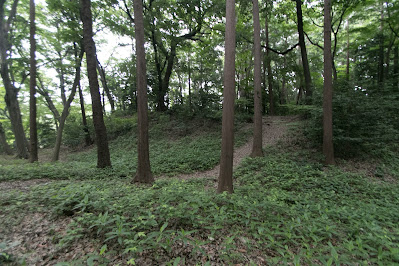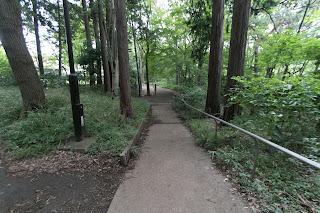Shakujii Castle
-Main base of pioneer of Tokyo metropolitan area-
Overview
Name: Shakujii castle (Shakujii-jo)
Alias:
Place: Shakujii-dai Nerima-ward, Tokyo
Type: Hill Castle
Built: 14th century
Remaining remnants: Clay walls and dry moats
Title:
Brief History
Shakujii castle (石神井城) is built over a plateau of about 20 meter height at the south of Sanpoji pond in the eastern half of current Shakujii-Koen park at Nerima Ward. Castle hill is a peninsular like ground between Sanpoji-ike pond and Shakujii-gawa river, which runs the center of Musashino Plateau toward from Fujimi pond toward Arakawa-river.
Before the construction of water lines in Edo era, top of Murashino plateau was a barren area because of the shortage of water. But there are several rivers flows from natural water sources such as Kanda-gawa river from Inokashira-ike pond, Meguro-gawa river from Benten-ike pond and Shakujii-gawa river from Fujimi-ike pond and Sanpoji-ike pond.
Origin of Toshima clan
In the medieval era which focused on rice cultivation, the seizure of water source was a critical matter to local lord, especially on the top of plateau which directly affected the income of the land. Medieval castles at the next of the pond or the inside of the valley were built not only to protect itself by water, but also to manage the water source. Shakujii-castle was a typical example of such castles.
Shakujii castle was built by local lord Toshima clan at the end of 14th century. Toshima clan was originally a family of Chichibu clan, one of major families of Taira clan reigned current Chichibu mountains of Saitama prefecture. One family of Chichibu clan achieved the manor of current Kita-ward of Tokyo Metropolis thus named as Toshima clan.
At the foundation of Kamakura Shogunate, Toshima clan belonged to Yoritomo Minamoto (1147-1199), the founder of Shogunate at the early stage of rise, thus became a direct retainer of Shogunate. Later Kasai clan, a branch family of Toshima clan which located at current Kasai area of Koto ward, was nominated as a supervisor of Tohoku region and moved to there.
Expansion into inland and build of Shakujii castle
Toshima clan was involved in several battles such as the battle of Jokyu, rise of Emperor Godaigo (1288-1339) and fall of Kamakura Shogunate, or battles between the South Court, Muromachi Shogunate and former retainers of Kamakura Shogunate. Losing many people in long time conflict but Toshima clan survived turbulent period and became local lord under Muromachi Shogunate.
Once the situation had stabilized, Toshima clan started the development of inland area Musashino Plateau thus moved its main base to the upstream of Shakujii river, to seize the water source. Shakujii river has a plenty water which was later used as a source of paper mills, and has many tributaries which enabled larger size development.
Along with the development of plateau, Toshima clan placed their relatives around the triangle area surrounded by current Arakawa river, Shakujii-gawa river and Shirako-gawa river. These branch families left their name as place names of towns of this area, such as Nerima, Shimura, Itabashi or Takinogawa, and shows Toshima clan was the origin of the north half of Tokyo area.
Peak of Toshima clan as local lord
Furthermore, Toshima clan contributed cultural development of area. As once Toshima clan became a magistrate of Kumano area of Kii province (Wakayama prefecture), they invited Kumano Shrine, the major shrine of Kumano area, to their territory as current Oji Shrine which keeps Oji Dengaku, a dance devoted to the god.
Also there are many temples around the area later regarded as Toshima 88 temples, and some of them were built under Toshima clan. By the middle of 15th century Toshima clan grew to the major local lord of Musashino Plateau, centered on Shakujii castle and Nerima castle, the one located at the place of Toshimaen park. Shakujii castle was also expanded along with the growth of Toshima clan.
Shakujii castle was built utilizing a peninsular like long and narrow plateau between main stream of Shakujii-gawa river and Sanpoji-ike pond. Unlike other castles built at the tip of the plateau, Shakujii castle is built at the middle of the plateau, to seize the spout of Sanpoji-ike to control the water flow from the pond.
Structure of Shakujii castle
Central area of Shakujii castle is roughly square shaped one of about 80 meter long. Now entrance to this part is limited but clay wall and dry moat of western line is well seen from outside of the fence. This line of clay wall is folded but it is not clear whether it is an artificial one to protect the entrance or just a shape of original terrain.
Central area is surrounded by Hikawa-Jinja Shrine at west, Sanpoji Temple at south and Dojoji temple at southwest. These temples and shrines are square shaped and has a trace of cliff at each line, and might be used as outer areas of Shakujii castle. Narrow road separating runs between these areas might be the ruin of old dry moat.
The east half of the plateau currently used as a part of Shakujii park might be used as residential area of retainers of Toshima clan. Although there is no remnant but there could be a fort at the tip of the height, to watch downstream of the river and besiege in case of emergency. Core area of Shakujii castle is about 200 meter square and larger than surrounding castles of other local lords, and shows the prosperity of Toshima clan.
Arrival of turbulent period
In the middle of 15th century, peace of Kanto region was suddenly broken. Kamakura Kubo highness, a representative of Muromachi Shogunate, and Kanto Kanrei, the highest retainer under Kamakura Kubo highness, became hostile by killing of Kanto Kanrei by Kamakura Kubo.
After the fierce battle, Kamakura Kubo highness was pushed out to the east half of Kanto region at the opposite side of Tone-gawa river formerly flow to Tokyo Bay, and west half of Kanto region was seized by Yamanouchi Uesugi clan, which was the house of Kanto Kanrei. Toshima clan belonged to Uesugi clan and there was no problem at this point.
However, to confront Kamakura Kubo army at the east side of Tonegawa river, Dokan Ota (1432-1486), the magistrate of Ogigayatsu Uesugi clan, a major branch family of Uesugi clan, proceeded to the south half of Musashino plateau. Dokan built Edo castle (Tokyo metropolis), Iwatsuki castle and Kawagoe castle (Saitama prefecture), and built triangle defense line toward Kamakura Kubo army.
Among two revolutionary generals
But this triangle defense line of Dokan directly overwrapped to the triangle territory of Toshima clan. As Dokan was at higher position, territory of Toshima clan was gradually declined by the pressure of Dokan. Toshima clan increased their dissatisfaction toward Dokan gradually.
Amid such situation, Kageharu Nagao (1443-1514), the person of Shiroi Nagao clan which served the chancellor of Yamanouchi Uesugi clan but could not take that position, raised his army against Yamanouchi Uesugi clan in 1476. Kageharu at first invited Dokan Ota who was distant relative of Kageharu to join his attempt, but Dokan refused it and fought for Uesugi clan.
Different from former generation generals who just gathered and attacked the enemy, Kageharu and Dokan were revolutionaries who could plan dimensional strategy using castles as critical points. In 1477 Kageharu urged Yasutsune Toshima (?-?), the leader of Toshima clan, to raise army to restrain Dokan at backward and separate from main army of Uesugi clan stayed at Ikakko area.
Defeat and fall of Shakujii castle
Dokan who was separated the connection from Edo castle to Iwatsuki castle or Kawagoe castle by Toshima clan needed to recover the route as soon as possible. If Toshima clan firmly secured their castles it would take time to break it, thus Dokan burnt down the castle town of Nerima castle, the branch castle at the center of territory by small army.
Toshima clan responded this provocation thus gathered their army from each castles then attacked the army of Dokan. But Toshima army suffered severe defeat by ambush tactics of Dokan at the battle of Egoda, and lost many soldiers along with younger brother of Yasutsune Toshima.
Yasutsune Toshima barely ran to Shakujii castle once surrendered to Dokan. But as Yasutsune did not destruct Shakujii castle as decided under the condition of peace, Dokan attacked Shakujii castle then Yasutsune escaped from castle. As a fictional tale, at the time of fall Yasutsune gallantly dived into Sanpoji pond riding white horse to kill himself, and his daughter Princess Teruhime followed it.
Afterward of Toshima clan and castle
In fact, Yasutsune survived this time and next year rose against Dokan again, but faced the attack of Dokan then went missing. Toshima clan held north part of Tokyo area over 400 years ended their history, being involved the conflict of two revolutionaries. Dokan who achieved the territory of Toshima clan became strong, but was later assassinated by his master Ogigayatsu Uesugi clan which feared the strength of Dokan.
As Dokan did not use Shakujii castle, the castle was abolished and was never used again. As the castle site was used as ground of shrines and temples to memory lost Toshima clan, losing most part of structure but atmosphere of the castle is still kept along with the clay wall of central area.
As the castles of Toshima clan were generally built at the edge of plateau, even though the structure was lost but there terrain shows the existence of castle well in the town. Beside, many of former castle town grew to the core of the area and becomes the places of train station with its name. Clear water of the pond tells the name of Toshima clan as the pioneer of Tokyo area until now, along with the place names around the north half of Tokyo metropolitan area.
Access
15 minutes walk from Seibu Ikebukuro line Shakujii-Koen station. 15 minutes drive from Kanetsu Jidoshado Expressway Oizumi interchange.






































































No comments:
Post a Comment